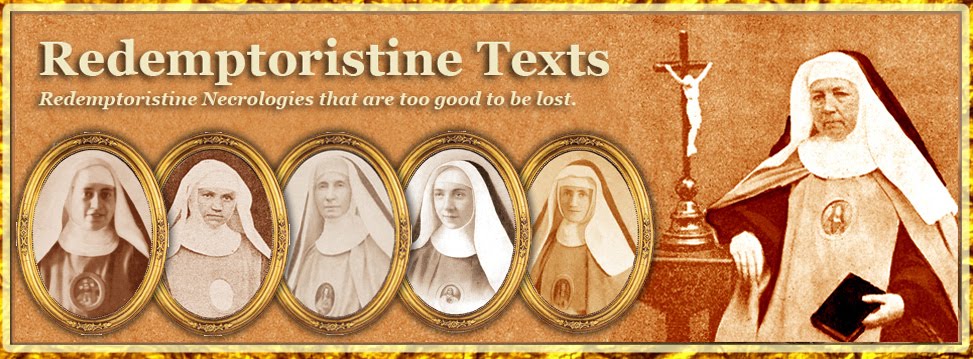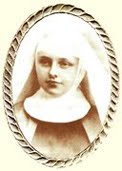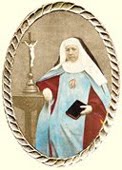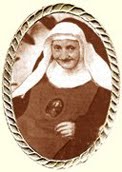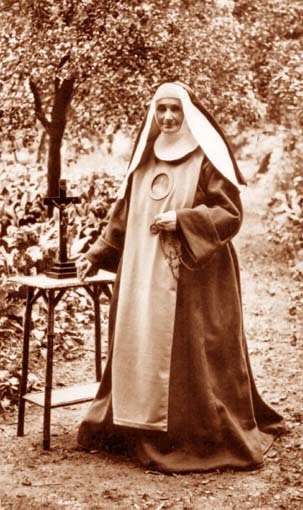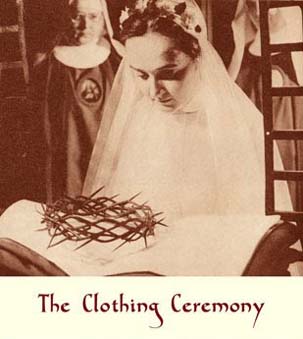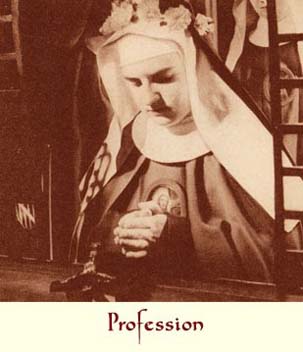It was on 25th March 1859 that the first Redemptoristine foundation was inaugurated at Dublin. Called by their state to relive the hidden life of Jesus at Nazareth, and in all the mysteries of His love, they came to God for the salvation of souls, upon this land of Ireland so fertile in noble devotions.
Among the faithful who crammed that day into their little chapel there was a young person who belonged to an excellent family in Dublin. She was called Anna O’Brien. She was the eldest daughter of Mr. O’Brien, a judge, and Marguerite Segrave, and was born on 13th June 1837. Her uncle, Mr. O’Farrell of Granite Hall, willingly opened his house to the Redemptorist Fathers when their apostolic work called them to Dublin. When it was a matter of founding a convent of Redemptoristines, the family took a great interest in this foundation, and the Rev. Fr. De Buggenoms himself stayed at Granite Hall until the last arrangements were finalized, and the Sisters were installed in a regular Monastery.
Miss Anna then felt an attraction for the religious life, with which she had previously been imbued, now awakening in her. Yet it was not without much combat that she followed God’s call. The world was smiling upon her, and her father belonged to the best society and occupied one of the highest positions of government. Was she not the eldest daughter, and the idol of her father, her mother and her grandmother? The young lady responded to all this affection and willingly turned her eyes to a smiling future.
The arrival of the Redemptoristines was to change her disposition. The eyes of Jesus made poor for love of us were fixed on her, and on the spot she asked Father de Buggenoms, her director, to present her as an Educande to Mother Mary-Jean of the Cross. At the ceremony on 25th March, which we have mentioned before, she was there, and when on 30th March, before the establishment of the enclosure, persons of the world were permitted one last time to visit the convent, she was there too, but no one could have suspected what she intended. However, her decision was made. When the Superior presented her to an old converse Sister as well able to become a Redemptoristine, the good religious drew the Superior apart and said to her: “Oh, Reverend Mother, please do not receive this elegant young lady into the extreme poverty we live in, for our house is so little in order!” “But”, says the Annalist of the convent, “little did they know about the heroic soul of Miss O’Brien.” To the eyes of the divine Redeemer she had replied: “Your light has shone upon me, and I shall rest in Your shadow.” And it was indeed the cross that she came to seek. It was with all her heart that she was to say goodbye to a comfortable life in order to embrace a life made up of abnegation and obedience.
* * * * *
On 8th April 1859, Anna O’Brien entered the convent as an Educande. She was then 22 years of age. She was offered a chance to postpone this date somewhat and go beforehand to visit Rome and receive the blessing of the sovereign Pontiff, but she made the sacrifice of this journey that she had desired for so long. Her mother thus offered her cherished daughter to God, but she did not give way to her in generosity. The Annalist says: “It was very edifying to see our dear Educande brave the difficulties of the little foundation with such good heart, embracing poverty so joyfully, and accepting and seeking her part in the common labours so eagerly. Her friends would have been astonished to see her take her very frugal repast from an old door placed on a barrel in a cold and damp cellar, while waiting for the refectory to be finished. However, poverty was always the favourite virtue of our dear Sister. She observed it in all its rigour, and her love of the common life was extreme. The enemy of every exception, she never wanted special food, not even when she was attacked by the cancer that caused her death and which she bore with an heroic courage.
On 19th March of the following year, on the feast of Saint Joseph, she received the holy red habit with the name of Sister Mary-Alphonsus of Jesus. “I feel very unworthy”, she wrote several days previously, “of the great favour that God has destined for me. I am going to receive the religious habit in order to repel forever any dealings with the world, and put on the habit of the Most Holy Redeemer in order to be betrothed to Jesus, who one day, I hope, will be my divine Spouse. Becoming a novice according to the spirit of our Father, Saint Alphonsus, is my sole desire and my dearest hope. In a few hours this hope will be realised, but what purpose will it serve if, in receiving the holy habit, I am not interiorly changed, if I am not inflamed with the divine love, an ardent charity and a tender compassion for the sufferings of my crucified Saviour? What shall I do if I am not filled with zeal for the conversion of the sinners for whom He poured out His blood to the very last drop on Calvary? It is on this sacred mountain that I must find my model, as the habit will only make me a novice of the Most Holy Redeemer to the proportion of the desire I have to imitate Him in His sufferings and His love.”
A year later, on 8th April 1861 (the feast of the Annunciation fell on Holy Monday and had been postponed to this day) our dear Sister Mary-Alphonsus of Jesus pronounced her holy vows with all the joy of her soul. She was just as she loved to say, “the first child of Saint Alphonsus in Ireland”, and she had, moreover, a tender and filial devotion for her Blessed Father, carefully studied his works and the least details of his life, and tried her best to imitate him, especially in perfect conformity to the will of God. She also attributed her happiness to the Blessed Virgin, whom she called “her tender Mother”, and to the good Saint Joseph, the patron of the interior life.
Then came the time to carry out the tasks that obedience entrusted to her. She was named Sacristan and fulfilled her office with the greatest care. Charged then with directing the Educandes and the Novices, she inspired in them a great esteem for their vocation, a great love for observance and the common life, and also inspired in them a horror for every singularity. She loved to repeat to them and have them write down this maxim several times: “We change, but God never changes.” She also said: “A Redemptoristine must try her best to travel by her love and the spirit of sacrifice along the rough paths that her divine Spouse followed and which lead her to the mountain of immolation.”
* * * * *
These rough paths of sacrifice and immolation, Sister Mary-Alphonsus of Jesus followed for twenty years without ever complaining.
Attacked by cancer in her stomach, she always tried to hide her sufferings, and never spoke of them except to her Superiors. However, they were very great, as the doctor who attended her confirmed. There was scarcely a night that brought her a few hours of rest, and she would usually spend them sitting in a little armchair. And then, she would remain in darkness, refusing even a small lamp through the spirit of poverty. In spite of this, the morning would find her applying herself to all her spiritual exercises. She always had the spirit of duty to a superior degree, and this spirit was also inspired by the spirit of love, and so she wanted only Jesus crucified to know the intensity of her sufferings.
On 16th April 1893, on the feast of the Holy Sepulchre, a redoubling of her sufferings suddenly gave alarm to the community. Sister Mary-Alphonsus struggled to get in line with the Sisters to be confessed. Her Superior, seeing her so eager, had her return to her cell, and Rev. Fr. Moore came to hear her confession. “The following morning,” says the Monastery Annalist, “we learned with the greatest sorrow that our dear invalid had spent a night in agony. The doctor was called in all haste and declared that her heart had succumbed to the violence of her pain, to which she replied with great resignation: ‘May God be blessed!’ and he ordered the last sacraments to be administered to her.”
The Reverend Mother Superior had Mons. Fitzpatrick called to hear the confession of the poor invalid before midday and he promised to return at one o’clock with the holy oils, but her illness got worse so quickly that they had to run to the Archbishop’s house, which was next to the convent. Doctor Magrath arrived immediately, and our dear Sister recognized him. Mons. Fitzpatrick followed, bearing the Blessed Sacrament and the holy oils. He had just enough time to give her communion and anoint her. Some moments afterwards, the beautiful soul of our dear Sister took its flight towards the eternal vision of God.
Although greatly afflicted by this loss, the community nonetheless saw in this sudden end a tender affection of divine Providence, which wished to spare our dear Sister the pangs of conscience that she had suffered from all her life. Her death was calm, peaceful and perfectly resigned to the will of God. After receiving the last sacraments, she told her Superior in her own manner: “I have made a great act.” Then she gave all those who surrounded her a last glance of farewell, affection and gratitude, raised her eyes towards Heaven and said: “My God, I render my soul into Your hands.” These were her last words.
The Annalist pays a last tribute to her Sister in these emotive terms: “Sister Mary-Alphonsus of Jesus, the eldest daughter of Judge O’Brien, was the first stone of this foundation and a precious gift of God in these beginnings. To her, to her dear family, and to their superabundant generosity we owe the profoundest gratitude. May the memory of the noble sacrifice she made of everything that could have made her happy in the world, her ardent love for her vocation, her heroic patience in suffering, and all her virtues, be engraved profoundly in the spirits of her afflicted Sisters, and may they be encouraged to imitate her examples in order to share one day in her reward!”
Among the faithful who crammed that day into their little chapel there was a young person who belonged to an excellent family in Dublin. She was called Anna O’Brien. She was the eldest daughter of Mr. O’Brien, a judge, and Marguerite Segrave, and was born on 13th June 1837. Her uncle, Mr. O’Farrell of Granite Hall, willingly opened his house to the Redemptorist Fathers when their apostolic work called them to Dublin. When it was a matter of founding a convent of Redemptoristines, the family took a great interest in this foundation, and the Rev. Fr. De Buggenoms himself stayed at Granite Hall until the last arrangements were finalized, and the Sisters were installed in a regular Monastery.
Miss Anna then felt an attraction for the religious life, with which she had previously been imbued, now awakening in her. Yet it was not without much combat that she followed God’s call. The world was smiling upon her, and her father belonged to the best society and occupied one of the highest positions of government. Was she not the eldest daughter, and the idol of her father, her mother and her grandmother? The young lady responded to all this affection and willingly turned her eyes to a smiling future.
The arrival of the Redemptoristines was to change her disposition. The eyes of Jesus made poor for love of us were fixed on her, and on the spot she asked Father de Buggenoms, her director, to present her as an Educande to Mother Mary-Jean of the Cross. At the ceremony on 25th March, which we have mentioned before, she was there, and when on 30th March, before the establishment of the enclosure, persons of the world were permitted one last time to visit the convent, she was there too, but no one could have suspected what she intended. However, her decision was made. When the Superior presented her to an old converse Sister as well able to become a Redemptoristine, the good religious drew the Superior apart and said to her: “Oh, Reverend Mother, please do not receive this elegant young lady into the extreme poverty we live in, for our house is so little in order!” “But”, says the Annalist of the convent, “little did they know about the heroic soul of Miss O’Brien.” To the eyes of the divine Redeemer she had replied: “Your light has shone upon me, and I shall rest in Your shadow.” And it was indeed the cross that she came to seek. It was with all her heart that she was to say goodbye to a comfortable life in order to embrace a life made up of abnegation and obedience.
* * * * *
On 8th April 1859, Anna O’Brien entered the convent as an Educande. She was then 22 years of age. She was offered a chance to postpone this date somewhat and go beforehand to visit Rome and receive the blessing of the sovereign Pontiff, but she made the sacrifice of this journey that she had desired for so long. Her mother thus offered her cherished daughter to God, but she did not give way to her in generosity. The Annalist says: “It was very edifying to see our dear Educande brave the difficulties of the little foundation with such good heart, embracing poverty so joyfully, and accepting and seeking her part in the common labours so eagerly. Her friends would have been astonished to see her take her very frugal repast from an old door placed on a barrel in a cold and damp cellar, while waiting for the refectory to be finished. However, poverty was always the favourite virtue of our dear Sister. She observed it in all its rigour, and her love of the common life was extreme. The enemy of every exception, she never wanted special food, not even when she was attacked by the cancer that caused her death and which she bore with an heroic courage.
On 19th March of the following year, on the feast of Saint Joseph, she received the holy red habit with the name of Sister Mary-Alphonsus of Jesus. “I feel very unworthy”, she wrote several days previously, “of the great favour that God has destined for me. I am going to receive the religious habit in order to repel forever any dealings with the world, and put on the habit of the Most Holy Redeemer in order to be betrothed to Jesus, who one day, I hope, will be my divine Spouse. Becoming a novice according to the spirit of our Father, Saint Alphonsus, is my sole desire and my dearest hope. In a few hours this hope will be realised, but what purpose will it serve if, in receiving the holy habit, I am not interiorly changed, if I am not inflamed with the divine love, an ardent charity and a tender compassion for the sufferings of my crucified Saviour? What shall I do if I am not filled with zeal for the conversion of the sinners for whom He poured out His blood to the very last drop on Calvary? It is on this sacred mountain that I must find my model, as the habit will only make me a novice of the Most Holy Redeemer to the proportion of the desire I have to imitate Him in His sufferings and His love.”
A year later, on 8th April 1861 (the feast of the Annunciation fell on Holy Monday and had been postponed to this day) our dear Sister Mary-Alphonsus of Jesus pronounced her holy vows with all the joy of her soul. She was just as she loved to say, “the first child of Saint Alphonsus in Ireland”, and she had, moreover, a tender and filial devotion for her Blessed Father, carefully studied his works and the least details of his life, and tried her best to imitate him, especially in perfect conformity to the will of God. She also attributed her happiness to the Blessed Virgin, whom she called “her tender Mother”, and to the good Saint Joseph, the patron of the interior life.
Then came the time to carry out the tasks that obedience entrusted to her. She was named Sacristan and fulfilled her office with the greatest care. Charged then with directing the Educandes and the Novices, she inspired in them a great esteem for their vocation, a great love for observance and the common life, and also inspired in them a horror for every singularity. She loved to repeat to them and have them write down this maxim several times: “We change, but God never changes.” She also said: “A Redemptoristine must try her best to travel by her love and the spirit of sacrifice along the rough paths that her divine Spouse followed and which lead her to the mountain of immolation.”
* * * * *
These rough paths of sacrifice and immolation, Sister Mary-Alphonsus of Jesus followed for twenty years without ever complaining.
Attacked by cancer in her stomach, she always tried to hide her sufferings, and never spoke of them except to her Superiors. However, they were very great, as the doctor who attended her confirmed. There was scarcely a night that brought her a few hours of rest, and she would usually spend them sitting in a little armchair. And then, she would remain in darkness, refusing even a small lamp through the spirit of poverty. In spite of this, the morning would find her applying herself to all her spiritual exercises. She always had the spirit of duty to a superior degree, and this spirit was also inspired by the spirit of love, and so she wanted only Jesus crucified to know the intensity of her sufferings.
On 16th April 1893, on the feast of the Holy Sepulchre, a redoubling of her sufferings suddenly gave alarm to the community. Sister Mary-Alphonsus struggled to get in line with the Sisters to be confessed. Her Superior, seeing her so eager, had her return to her cell, and Rev. Fr. Moore came to hear her confession. “The following morning,” says the Monastery Annalist, “we learned with the greatest sorrow that our dear invalid had spent a night in agony. The doctor was called in all haste and declared that her heart had succumbed to the violence of her pain, to which she replied with great resignation: ‘May God be blessed!’ and he ordered the last sacraments to be administered to her.”
The Reverend Mother Superior had Mons. Fitzpatrick called to hear the confession of the poor invalid before midday and he promised to return at one o’clock with the holy oils, but her illness got worse so quickly that they had to run to the Archbishop’s house, which was next to the convent. Doctor Magrath arrived immediately, and our dear Sister recognized him. Mons. Fitzpatrick followed, bearing the Blessed Sacrament and the holy oils. He had just enough time to give her communion and anoint her. Some moments afterwards, the beautiful soul of our dear Sister took its flight towards the eternal vision of God.
Although greatly afflicted by this loss, the community nonetheless saw in this sudden end a tender affection of divine Providence, which wished to spare our dear Sister the pangs of conscience that she had suffered from all her life. Her death was calm, peaceful and perfectly resigned to the will of God. After receiving the last sacraments, she told her Superior in her own manner: “I have made a great act.” Then she gave all those who surrounded her a last glance of farewell, affection and gratitude, raised her eyes towards Heaven and said: “My God, I render my soul into Your hands.” These were her last words.
The Annalist pays a last tribute to her Sister in these emotive terms: “Sister Mary-Alphonsus of Jesus, the eldest daughter of Judge O’Brien, was the first stone of this foundation and a precious gift of God in these beginnings. To her, to her dear family, and to their superabundant generosity we owe the profoundest gratitude. May the memory of the noble sacrifice she made of everything that could have made her happy in the world, her ardent love for her vocation, her heroic patience in suffering, and all her virtues, be engraved profoundly in the spirits of her afflicted Sisters, and may they be encouraged to imitate her examples in order to share one day in her reward!”
This necrology is translated from Fleurs de l'Institut des Rédemptoristines by Mr John R. Bradbury. The copyright of this translation is the property of the Redemptoristine Nuns of Maitland, Australia. The integral version of the translated book will be posted here as the necrologies appear.
